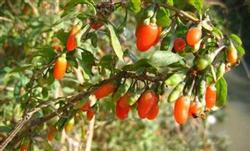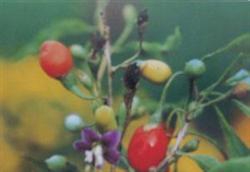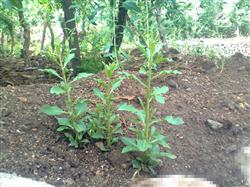Cultivation techniques of Lycium barbarum in Ningxia

Ningxia Lycium barbarum (Ningqi No. 1 and Ningqi No. 2) is planted in the northern region, with a yield of about 250kg of dried fruit and an income of about 4000 yuan per 667m2, calculated at 16 yuan per kilogram, which is a good way for farmers to get rich. First, Chinese wolfberry is lax in soil requirements for land selection and preparation, and is resistant to drought, barren, saline-alkali and sand famine. In order to obtain high quality and high yield, it should be planted on sandy loam near water source (ph is about 8.0). After autumn crop harvest, organic fertilizer 5000kg, nitrogen, phosphorus and potassium compound fertilizer 100kg, ploughing depth above 30cm, leveling the land and pouring frozen water were applied to every 667m2 of soil preparation. Before sowing in the next spring, shallow ploughing and fine raking should be made into a flat bed with a width of 1m, and it would be better for the border to run north-south. Second, propagation method Lycium barbarum has strong reproductive ability, which can be propagated by seeds, cuttings and ramets. (2) Cuttage propagation: cutting propagation is the main way to grow Chinese wolfberry in the north of the Yangtze River. When the plant height is 1 m and there are 4 fibrous roots, about 250 plants are planted per 667 square meters, the plant spacing is 1.2-1.5 m and the row spacing is 1.8-2.0 m, both ridge and furrow planting. (3) split propagation: it is advisable to transplant the tillering seedlings on the horizontal root of the mother plant 3~7cm. 3. Field management (1) weeding by intertillage: weeding by intertillage for 5 or 6 times a year, with a depth of 7~10cm. The garden should be turned twice a year to enhance soil permeability, preserve soil moisture and promote root development. The first time in early spring in April, deep 13cm, the second time in late October, deep into 20~25cm. (2) fertilization and irrigation: Chinese wolfberry avoid excessive humidity and poor drainage, and drought affects its growth and fruit, so it should be watered in time. For some droughts after the beginning of spring, they should be irrigated every 10 to 15 days, and during fruit picking, they should be irrigated for every two times, timely drainage in the rainy season, and winter water before freezing. In the middle and first ten days of November, according to every (667m2) 2000kg, open a ring-shaped ditch on one side of the tree, apply a rotten barnyard manure, etc., cover soil and water after application. From May to June, during the peak flowering and fruiting period, nitrogen fertilizer was applied 2 times and 100 grams of urea, ammonium sulfate and ammonium nitrate were applied to each plant, and then irrigated immediately. (3) pruning: annual Lycium barbarum, fixed trunk height 50~60cm, cut off the top, at the place of 4~5cm under the cut mouth, leave 3 or 5 evenly distributed and robust technical strips as the main branch; biennial Lycium barbarum, the main branch leaves long 30~40cm, the side branch leaves 20cm, and other branches with gaps leave 8~10cm to form the first layer of crown. For Lycium barbarum which is more than three years old, there are 40~50cm in the main and lateral branches, 20~30cm in the lateral branches, and one branch in every 15cm on the lateral branches. the height of the tree is not more than 1.5m and the diameter of the crown is less than 1.5m. After shaping, it is necessary to often cut off withered, diseased and weak branches to maintain a tree type with high and stable yield. Fourth, the resistance of Lycium barbarum in disease control is relatively strong, and diseases and insect pests rarely occur. The main diseases of Lycium barbarum are black fruit disease and root rot. At the initial stage of the onset of black fruit disease, 1 ∶ 120 ~ 160 Bordeaux solution, 50% wettable acetaminophen 1000 times or 65% wettable manzin 500 times could be sprayed once every 7 to 10 days. Root rot. At the initial stage of the disease, 50% carbendazim 1000-1500 times solution can be used for root control, or immediately pull out the diseased plant and disinfect the soil around the diseased plant with lime. The main pests are Lycium barbarum fruit fly, gall mite and so on. When damage to fruit flies occurs, it can be sprayed with 1500 times of 90% dipterex or 40% dimethoate EC, and diseased fruits can also be picked and buried deeply; in order to prevent the occurrence of gall mites, spray with 40% dimethoate EC 1000-1500 times in spring, once every 10 days, 3 times in a row. Fifth, the fruit is generally harvested 50-60 days after cutting (from mid-June to early August). When picking, light picking and light handling, fruit storage thickness does not exceed 5~10cm, fresh fruit just picked should not be exposed to the strong light at noon within two days, can not be turned by hand, to prevent rupture, should be hung until the skin wrinkles, and then exposed to the skin dry hard, soft pulp.
- Prev

How to prevent and cure black fruit disease of Chinese wolfberry
Black fruit disease is one of the main diseases of Chinese wolfberry. The pathogen harms the green fruits, flowers and buds of Chinese wolfberry, as well as twigs and leaves. After the disease of Chinese wolfberry green fruit, small black spots or black spots or black reticular lines begin to appear. On cloudy and rainy days, the disease spot expands rapidly, which blackens the fruit and grows orange conidia, which cannot be used as medicine. ...
- Next

Management of juvenile stage of Lycium barbarum
After the seedlings planted by fixed stem pruning sprout, cut off the buds below 30 cm above the trunk basal stem (branch band). Above the branch belt, 3-5 lateral buds or lateral branches with 3 cm-5 cm spacing are selected as backbone branches (the first layer crown of the crown) to form a small crown, and the height is 40 cm-50 cm.
Related
- Fuxing push coffee new agricultural production and marketing class: lack of small-scale processing plants
- Jujube rice field leisure farm deep ploughing Yilan for five years to create a space for organic food and play
- Nongyu Farm-A trial of organic papaya for brave women with advanced technology
- Four points for attention in the prevention and control of diseases and insect pests of edible fungi
- How to add nutrient solution to Edible Fungi
- Is there any good way to control edible fungus mites?
- Open Inoculation Technology of Edible Fungi
- Is there any clever way to use fertilizer for edible fungus in winter?
- What agents are used to kill the pathogens of edible fungi in the mushroom shed?
- Rapid drying of Edible Fungi

